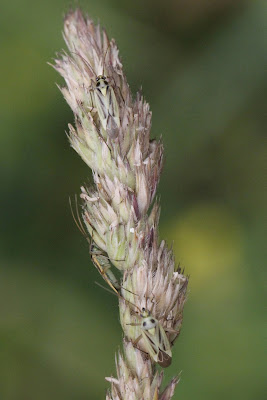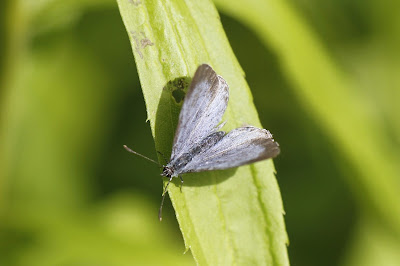On a grass seed head , several cocoons . I sent this picture to Martin / Martin's Butterflies , who was of the opinion that they were those of a parasite , Ichneumon or something similar . The female parasite would have layed her eggs on or in the host . Having hatched , the larvae concentrate on feeding on the non-essential organs of the host , thus keeping the host alive . Once fully grown , the larvae start on the essential organs of the host and kill it . They then pupate in cocoons like this , the host , now no more than a shrivelled skin , dropping to the ground . Thanks for that Martin .
This Yellow and Black Longhorn Beetle / Rutpela maculate has been in very short supply this year , usually they are swarming all over the Bramble flowers , but very few seen .
Also on grass seed heads , lots of these tiny Mirid or Capsid bugs , with their 'goulish , smiling face' markings .
The butterfly transect , snatched one windy afternoon , produced 20 species , the best so far this year , but was still woefully low in individual species numbers , apart from Meadow Brown and a surprising 23 Large White and 28 Small Skipper . Highlights were a first confirmed WLH , high in
the Ash tree , a second White Admiral , showing it had been out for some time , and two very fresh
Common Blue , the first specimens of the second brood seen on site this year , just hoping they will do better than the first brood which was very poor in number .
A few other finds at High Elms included ;
Finally managed to capture a male Gatekeeper , open winged ,
and later found that the females too had emerged .
Somewhat of a rarity on site this year , a Holly Blue . This a female .
Lots of courting Meadow Brown , but caught these two , male on left , taking a breather .
Towards the end of the week , an explosion in emergence of Comma . This one was shy , but on a nearby Buddleia bush a minimum of 12 were recorded , now changing from their early golden topwing colour , to their tawny red hue .
The female Silver-washed Fritillaries are now getting down to the important egg laying . Several seen laying their eggs up to 5 metres up tree trunks , but always with Violets growing underneath for their larvae to feed on .
6-spot Burnet Moths have also emerged , and are not wasting time .
Down in the grass on Burnt Gorse , was this colourful moth , Oncocera semirubella , apparently no common name yet , having migrated over from the continent , and now resident in Southern counties .
1/2 Brown Hawkers have been patrolling the bottom glade , but not perching , but on Saturday , this immature female Southern Hawker was willing to pose , just for a few seconds .
A look in on a very quiet Common , found the Broad-leaved Helleborines just about to burst bud into flower ,
and the strange looking fly Sicus ferrugineus , with it's abdomen curled under , was all I found .
Helping out with the Down House butterfly survey , plenty of 'Hull City supporters' , caterpillars of the Cinnabar moth were found on the Ragwort , their foodplant ,
and it was good to record 3 Small Copper , a species that seems to have declined dramatically locally.
Almost at the end of the transect , this striking female Painted Lady was found , nectaring on Purple Loosestrife in the walled garden .
My highlight was putting up two Roe Deer fawns , accidentally , from the long grass as we crossed the large meadow . They bounded in different directions and all I got was a rear end of one as it headed for the edge of the meadow .
Yesterday , 30+ Kent BC members came on the High Elms butterfly walk , in what turned out to be perfect conditions , after the opposite had been forecasted all week . Just 16 species were seen , but more importantly , the SWF put on a great show , 2 White-letter Hairstreak were found nectaring on the Canadian Golden Rod and gave all present plenty of time to get their pictures . White Admiral did let us down , as did Common and Holly Blue , Brown Argus , Red Admiral , Sm.Tortoiseshell , Dark Green Fritillary and especially , the Purple Emperor , but everyone seemed to go away happy with what had been seen and photographed .






















4 comments:
Haven't recorded a single Brown Argus here this year Greenie :-( Also, Ive only seen two Common Blues!
Greenie.
Nice posting, good selection of photo's. One of natures gruesome facts about the parasite.
Pity you missed out on quite a few on your walk.
Some years ago we Christened Oncocera semirubella as the High Elms Rhubarb and Custard Moth after the pink and yellow sweets we all ate as kids - remember them?
High Elms Admin ,
Sadly , I can't re-call those pink and yellow sweets , but I seem to remember my old Dad talking about them !!!
I found several more Oncocera semirubella during the butterfly transect around the Burnt Gorse area last Thursday .
Post a Comment